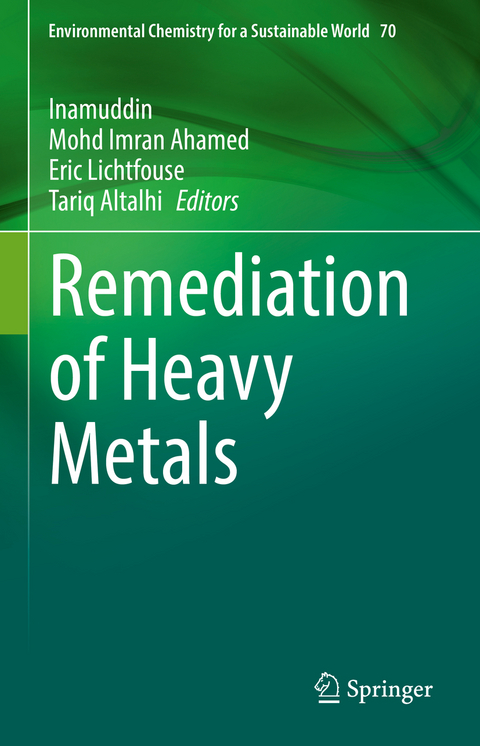
Remediation of Heavy Metals
Springer International Publishing (Verlag)
978-3-030-80333-9 (ISBN)
lt;p>Dr. Inamuddin, is an assistant professor at the Department of Applied Chemistry, Zakir Husain College of Engineering and Technology, Faculty of Engineering and Technology, Aligarh Muslim University, Aligarh, India. He has extensive research experience in multidisciplinary fields of analytical chemistry, materials chemistry, electrochemistry, renewable energy and environmental science. He has worked on different research projects funded by various government agencies and universities and is the recipient of awards, including the Fast-Track Young Scientist Award and the young researcher of the year award-2020 of the university. He has published about 186 research articles in various international scientific journals, 18 book chapters, and 134 edited books with multiple well-known publishers. His current research interests include ion exchange materials, a sensor for heavy metal ions, biofuel cells, supercapacitors and bending actuators.
Dr. Mohd Imran Ahamed is working as Research Associate at the Department of Chemistry, Aligarh Muslim University (AMU), Aligarh, India. He received his B.Sc. (Hons) Chemistry and Ph.D. (Chemistry) degrees from AMU. He has completed his M.Sc. (Organic Chemistry) from Dr. Bhimrao Ambedkar University, Agra, India. He has published several research and review articles in various international scientific journals. He has co-edited books of international repute. His research work includes ion-exchange chromatography, wastewater treatment, and analysis, bending actuator and electrospinning. His research work includes ion-exchange chromatography, wastewater treatment, and analysis, bending actuator and electrospinning.
Dr. Eric Lichtfouse is a professor of environmental chemistry and scientific writing at Aix Marseille University and Xi'an Jiaotong University, and Chief Editor and co-founder of the journal Environmental Chemistry Letters. He has invented carbon-13 dating following the discovery of various temporal pools of a single individual organic substance in soils. He has published the book Scientific Writing for Impact Factors, which includes a new tool - the Micro-Article - to identify the novelty of research results. He got the analytical chemistry prize from the French Chemical Society, the grand prize of the Universities of Nancy and Metz, and a journal citation award by the Essential Indicators. He is world XTerra vice-champion and ITU cross triathlon world bronze medal in the age category.
Dr. Tariq Altalhi, joined the Department of Chemistry at Taif University, Saudi Arabia as Assistant Professor in 2014. He received his doctorate degree from University of Adelaide, Australia in the year 2014 with Dean's Commendation for Doctoral Thesis Excellence. He was promoted to the position of the head of Chemistry Department at Taif university in 2017 and Vice Dean of Science college in 2019 till now. In 2015, one of his works was nominated for Green Tech awards from Germany, Europe's largest environmental and business prize, amongst top 10 entries. His group is involved in fundamental multidisciplinary research in nanomaterial synthesis and engineering, characterization, and their application in molecular separation, desalination, membrane systems, drug delivery, and biosensing. In addition, he has established key contacts with major industries in Kingdom of Saudi Arabia.
Chapter 1 Analytical methods for the determination of heavy metals in water.- Chapter 2 Olive-oil waste for the removal of heavy metals from wastewater.- Chapter 3 Metal oxide composites for heavy metal ions removal.- Chapter 4 Two-dimensional materials for heavy metal removal.- Chapter 5 Membranes for heavy metals removal.- Chapter 6 Metal oxides for removal of heavy metal ions.- Chapter 7 Organic-Inorganic Ion Exchange Materials for Heavy Metal Removal from Water.- Chapter 8 Low-cost technology for heavy metal cleaning from water.- Chapter 9 Use of nanomaterials for heavy metal remediation.- Chapter 10 Ecoengineered approaches for the remediation of polluted river ecosystems.- Chapter 11 Ballast water definition, components, aquatic invasive species, control and management and treatment technologies.- Chapter 12 Source, pollution and remediation of carcinogenic hexavalent chromium from industrial, mining effluents.- Chapter 13 Pesticides in Drinking Water and Removal Techniques.-Chapter 14 Opportunities and challenges in heavy metal removal from water.- Chapter 15 Modification of Bagasse for Heavy Metal Removal form Water.- Chapter 16 Chelating materials for the removal of heavy metals from water.- Chapter 17 Sources of heavy metals pollution.
| Erscheinungsdatum | 12.11.2021 |
|---|---|
| Reihe/Serie | Environmental Chemistry for a Sustainable World |
| Zusatzinfo | XII, 454 p. 1 illus. |
| Verlagsort | Cham |
| Sprache | englisch |
| Maße | 155 x 235 mm |
| Gewicht | 902 g |
| Themenwelt | Naturwissenschaften ► Biologie ► Biochemie |
| Schlagworte | biowaste • Chelating Materials • composite materials • Heavy metal • Ion Exchange Materials • Metal Oxides • wastewater |
| ISBN-10 | 3-030-80333-3 / 3030803333 |
| ISBN-13 | 978-3-030-80333-9 / 9783030803339 |
| Zustand | Neuware |
| Informationen gemäß Produktsicherheitsverordnung (GPSR) | |
| Haben Sie eine Frage zum Produkt? |
aus dem Bereich


